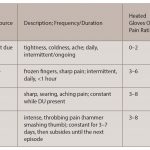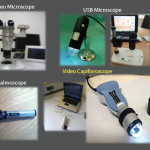Ischemic Digital Ulcers: No DU developed during the intervention period (see Figure 3).
Secondary Measures
Strength: Grip strength decreased 1.4 lbs. in the right hand and increased 2.3 lbs in the left. Right and left lateral pinch decreased 1.6 lbs. and 1.0 lb., respectively. The right three-point pinch decreased 2.7 lbs. There were increases in the right two-point pinch, 1.7 lbs., and the left three-point pinch, 1.0 lb. (see Table 1).
Active Range of Motion: There was a 1º increase in active right wrist extension and 3º increase in wrist flexion. Left wrist extension and flexion each decreased by 3º. The right second digit active ROM increased in all joints by 2–5º. The right 5th digit decreased MCP and DIP flexion by 6º and 4º, respectively. The left 2nd digit increased PIP extension 5º and both PIP and DIP flexion by 3º. The left 5th digit increased PIP flexion 2º and DIP flexion 3º. There was a decrease in MCP flexion by 1º and DIP extension 3º (see Table 2).
Sensation: Sensation improved in the left 2nd through 5th digits and the right 4th and 5th digits. The left 2nd digit improved from 4.0 g, loss of protective sensation, to 2.0 g, reduced protective sensation. The left 5th digit improved from 2.0 g, reduced protective sensation, to 0.07 g within normal range. An improvement from 2.0 g, reduced protective sensation, to 0.2 g, reduced tactile sensation, was noted in the left 3rd and 4th digit and the right 4th digit (see Table 3).
Dexterity: Barb completed the nine-hole pegboard test faster by 1.33 seconds with her right hand and by 3.72 seconds with her left hand (see Table 3).
Function & Joint Mobility Tests: The HAMIS test score improved in the right hand by two points, but not in the left. The Modified Kapanji Index showed an improvement in right thumb opposition and right and left long finger flexion. Total score was 84 out of 100 points (see Table 3).
Discussion
In this case study, continuous use of heated gloves provided protection and addressed the vascular issues in dSSc. The daily use of heated gloves for more than six hours per day provided continuous warmth to Barb’s fingertips. In turn, her pain was decreased, and no digital ulcers formed during the intervention period. Barb credited the gloves with preventing or stopping Raynaud’s episodes quickly, thereby enabling her to use her hands more readily.
Heated gloves are neat and effective. The gloves freed up her time and her hands, and enabled her to more comfortably complete tasks and function in cold environments. She achieved her goals.


